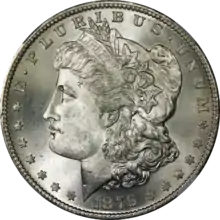George T. Morgan
George Thomas Morgan (November 24, 1845 – January 4, 1925) was a United States Mint engraver who is famous for designing many popular coins, such as the Morgan dollar and the reverse of the Columbian Exposition half dollar.
George T. Morgan | |
|---|---|
 A photograph of the Mint engravers. Morgan is seated in the front row, second from right. | |
| Chief Engraver of the United States Mint | |
| In office 1917–1925 | |
| Preceded by | Charles E. Barber |
| Succeeded by | John R. Sinnock |
| Personal details | |
| Born | November 24, 1845 Birmingham, England |
| Died | January 4, 1925 (aged 79) United States |
| Occupation | Engraver |
Biography
Morgan was born in Birmingham, England where he worked for many years as a die engraver. He came to the United States in 1876 and was hired as an assistant engraver at the Mint in October under William Barber. He figured very prominently in the production of pattern coins from 1877 onward, and designed several varieties of 1877 half dollars, the 1879 "Schoolgirl" dollar, and the 1882 "Shield Earring" coins. He became the seventh Chief Engraver of the United States Mint following the death of Charles E. Barber in February 1917.
Morgan is most famous for designing the Morgan dollar, one of many namesakes, as well as the never-released $100 Gold Union coin.


References
- Gibbs, William T. (October 2012). "Morgan's half dollars". Coin World: 4–5, 14, 20, 22, 24, 28, 32, 36, 40. Cite journal requires
|journal=(help) - Lee, Karen M. (2013). The Private Sketchbook of George T. Morgan. Atlanta, Ga.: Whitman Publishing. ISBN 978-079483822-5.
External links
| Government offices | ||
|---|---|---|
| Preceded by Charles E. Barber |
Chief Engraver of the United States Mint 1917–1925 |
Succeeded by John R. Sinnock |